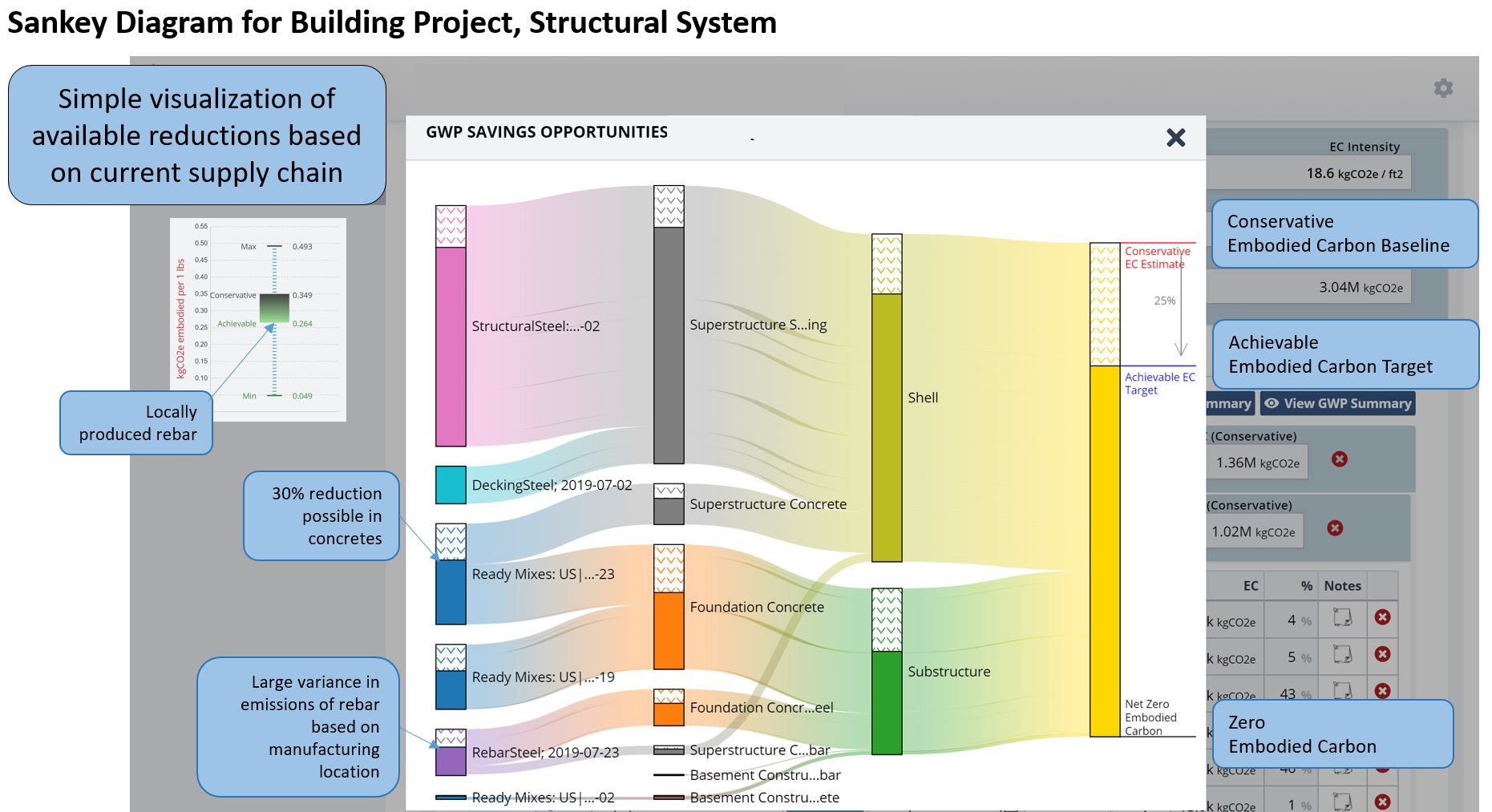Our industry has long known the impacts of embodied carbon in construction but has wrestled with how to incorporate this information into our practice. Finally, after years of conversations and confusion, on September 23, 2019, the Carbon Leadership Forum announced a solution. In partnership with more than 30 forward-looking and innovative building industry companies, they have taken on a long-elusive goal: measuring and reducing the carbon footprint of building materials. The result is the Embodied Carbon in Construction Calculator (EC3) tool, a free, open-access tool for architects, engineers, owners, construction companies, building material suppliers and policy makers to compare and reduce embodied carbon emissions from construction materials. I’m very proud to say that we are one of the pilot partners involved with testing this ambitious tool on two projects.

Background on the EC3 Tool
Currently, our industry successfully understands and calculates impacts from operational carbon, yet embodied carbon (defined as the carbon emissions associated with the extraction, manufacturing, transport and installation of building materials) is the latest featured player in the story of carbon emissions reduction. The landscape of carbon and sustainability continues to evolve as our industry learns and establishes more concrete (no pun intended) data. The EC3 tool is primed to help radically shift the way the AEC industry designs buildings by informing us about the products that we specify — from structural components to interiors finishes. It provides a portal of information to review the embodied carbon content in all our building materials and aid in our design discussions and decision-making processes. The previously esoteric concept of embodied carbon is now being simplified to fit into our workflows.
As pilot partner, we’re currently testing the EC3 tool on two of our own projects: the Newark Civic Center in Newark, California and an office campus in the Greater Seattle area, Washington. In addition to testing the tool on these projects, we’re also hosting internal tutorials and demos for our curious designers who are passionate about sustainability and eager to learn more about this new tool prior to its November 19th public beta launch date. During these internal training demos, we unveil the EC3 tool’s user interface, input fields, and end results. During these sessions, I am often met with a barrage of emotions: excitement, inspiration, confusion, hesitation, and pause. As our firm-wide Research Knowledge Manager, this grab-bag of audience reactions is familiar ground for me. I get these responses whenever I am first introducing a new group of people to our research efforts at Perkins&Will.

Same Reactions, Different Platform
The notion of change management is critical to incorporating research into practice; and the previously described emotions are a direct result of human nature being confronted with change. Whether it’s a new tool (like the EC3 tool or our own SPEED tool), a process (like the Design Space Construction framework), or knowledge collateral (like our Transparency portal), there is always going to be initial uncertainty on when it makes sense for a project team to incorporate it into the design process. The question of “how to incorporate THIS” will always remain. The EC3 tool, much like other products of our various research labs, have a diverse group of end users with the potential to reach across all our different practice areas. Whether it’s applying thought leadership, incorporating new knowledge, or employing a tool that’s meant to help quantify embodied carbon, the business of simplification is ironically very complex.
What drew me to the EC3 tool is the amount of academic rigor that has gone into the development of the tool’s credibility. The Carbon Leadership Forum has done an exceptional job of casting a wide net of lead collaborators and industry partners and reached out to experts in various University of Washington departments for input to ensure the tool’s methodology is credible. The tool’s data sources are verified Environmental Product Declarations (EPD’s), but the methodology to uniformly address data uncertainty and variability is the heartbeat that gives the tool life (in addition to the user interface). I’m not only inspired by this collaborative approach, but I believe in this tool because of its rigor. This is not unlike the feeling I have with our own Perkins&Will Research Labs. We rely on a combination of evidence-based research, literature reviews, iterative processes, and peer-review validation which comprise the rigor behind our research ecosystem.
Oftentimes, tools created with the intent of making things easier are perceived as hurdles. Questions arise such as, ‘How do you incorporate your research hours into your workplan?’ Or, ‘How do you raise these questions, tools and process with your project teams and clients?’ And most importantly, there is often a fear that including research steps in your process will prolong or delay your schedule. On the flipside, there’s also an eagerness to include these tools to improve our designs, and exhibit thought leadership. I see people grappling with how to execute new research effectively; and I get the sense that the launch of the EC3 tool won’t be any different. The beauty of discovering that we’re all struggling together, is that it makes for a great team building scenario. For an effort that is truly breaking down silos in our AEC industry and fostering partnerships amongst companies that are often seen as competitors, it is great to see this type of effort for the greater good. The complete carbon story needs to be understood and told by our design teams, collaborators, and clients. People are used to doing things in their own way, but now is the time to embrace change and disrupt the status quo.

Leveraging What We’ve Learned
Since I’m no stranger to the spectrum of emotions that a new tool evokes, I feel I’m in a unique position to share some lessons I’ve learned to help ensure smooth integration of the EC3 tool. Firstly, it’s imperative to have early adopters to navigate the waters of uncertainty and show the way forward. Many of the EC3 tool’s early adopters are (or will be) the sustainability gurus in each of our studios; people who have a passion for understanding the carbon impact from designs and keen to see what tools are at their disposal to minimize that impact. Those early adopters will be crucial team members in communicating how and when to use the tool.
Secondly, if your firm has people located in various locales, try to ensure you have at least one key user, or champion, in each office. That person can be an invaluable resource for several project teams. Thirdly, since the EC3 tool is intended to reach a broad audience, I recommend staying flexible in order to cater your message accordingly. The more willing you are to change your approach to communicate the same content differently and in the language of the audience, the more successful your reach will be.
Fourthly, anticipate and expect that the EC3 tool will continually evolve and update. Much like how our Transparency portal has been updated to include new information about various materials (such as flame retardants and methyl methacrylate (MMA)), the EC3 tool will be updated to include more products and stages of the life cycle analysis. The more you remind projects teams to expect new versions of the tool, the more effectively teams can prepare. And lastly, don’t underestimate the value of case studies. Whenever possible, if you can share even one retroactive case study to exemplify how the tool has worked for a project team, that will help drive the embodied carbon message home.
The launch of the EC3 tool may be a different melody of a familiar song, but this chorus of industry voices singing together to improve the performance and experience of the built environment sounds pretty sweet.
Learn More
- For more information about the Carbon Leadership Forum and the EC3 tool, including links to our partners’ announcements visit carbonleadershipforum.org
- Visit https://buildingtransparency.org and register to have access to the EC3 tool.
- World Green Building Council Report: Bringing Embodied Carbon Upfront https://www.worldgbc.org/news-media/bringing-embodied-carbon-upfront